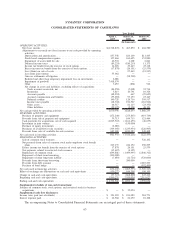Symantec 2009 Annual Report Download - page 124
Download and view the complete annual report
Please find page 124 of the 2009 Symantec annual report below. You can navigate through the pages in the report by either clicking on the pages listed below, or by using the keyword search tool below to find specific information within the annual report.
SYMANTEC CORPORATION
Notes to Consolidated Financial Statements
Note 1. Summary of Significant Accounting Policies
Business
Symantec Corporation (“we,” “us,” and “our” refer to Symantec Corporation and all of its subsidiaries) is a
global leader in providing security, storage and systems management solutions to help businesses and consumers
secure and manage their information. We provide customers worldwide with software and services that protect,
manage and control information risks related to security, data protection, storage, compliance, and systems
management. We help our customers manage cost, complexity and compliance by protecting their IT infrastructure
as they seek to maximize value from their IT investments.
Principles of Consolidation
The accompanying consolidated financial statements of Symantec Corporation and its wholly-owned sub-
sidiaries are prepared in conformity with generally accepted accounting principles in the United States. All
significant intercompany accounts and transactions have been eliminated. Certain prior year amounts have been
reclassified to conform to the current presentation.
Fiscal Years
We have a 52/53-week fiscal year ending on the Friday closest to March 31. Unless otherwise stated,
references to years in this report relate to fiscal years rather than calendar years.
Fiscal Year Ended Weeks
2009 April 3, 2009 53
2008 March 28, 2008 52
2007 March 30, 2007 52
The fiscal year ending April 2, 2010 will comprise 52 weeks of operating results.
Use of Estimates
The preparation of consolidated financial statements in conformity with generally accepted accounting
principles in the United States requires management to make estimates and assumptions that affect the amounts
reported in the consolidated financial statements and accompanying notes. Estimates are based upon historical
factors, current circumstances and the experience and judgment of management. Management evaluates its
assumptions and estimates on an ongoing basis and may engage outside subject matter experts to assist in its
valuations. Actual results could differ from those estimates. Significant items subject to such estimates and
assumptions include those related to the allocation of revenues between recognized and deferred amounts, fair value
of financial instruments, valuation of goodwill, intangible assets and long-lived assets, valuation of stock-based
compensation, contingencies and litigation, and the valuation allowance for deferred income taxes.
Foreign Currency Translation
The functional currency of our foreign subsidiaries is generally the local currency. Assets and liabilities
denominated in foreign currencies are translated using the exchange rate on the balance sheet dates. Revenues and
expenses are translated using monthly average exchange rates prevailing during the year. The translation adjust-
ments resulting from this process are included as a component of Accumulated other comprehensive income.
Foreign currency transaction gains and losses are included in Other income, net. When legal entities are liquidated,
reclassification translation adjustments are made from Accumulated comprehensive income to Other income, net.
Deferred tax assets (liabilities) are established on the cumulative translation adjustment attributable to unremitted
foreign earnings that are not intended to be indefinitely reinvested.
64
























